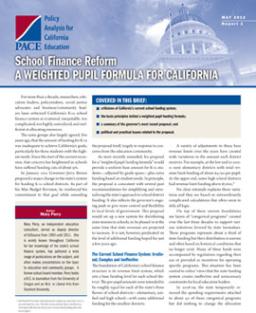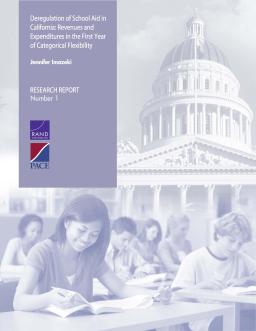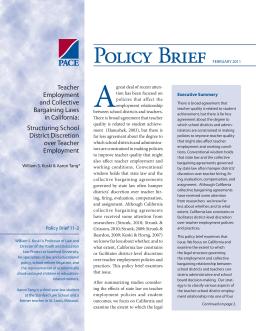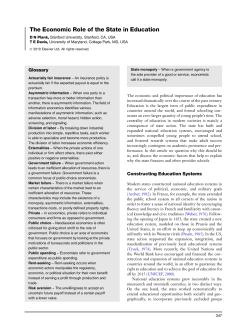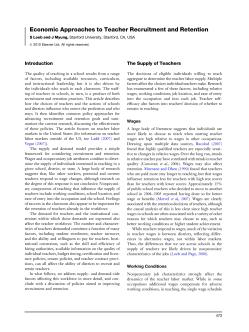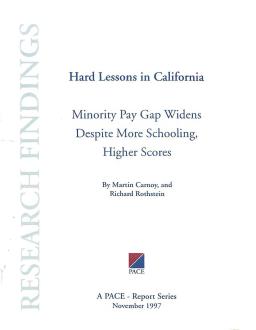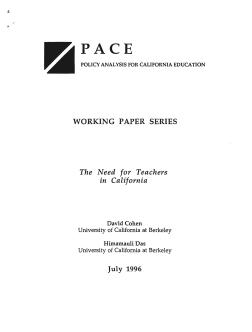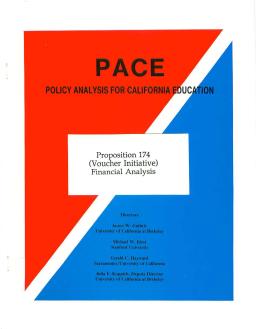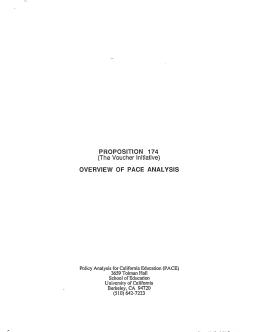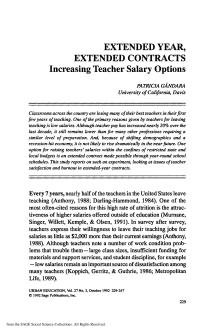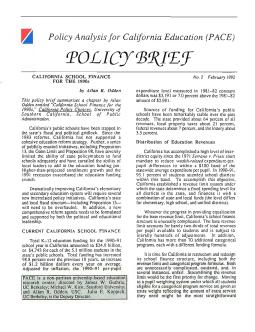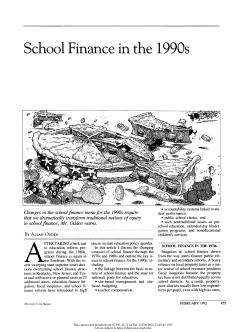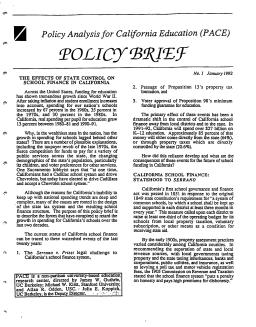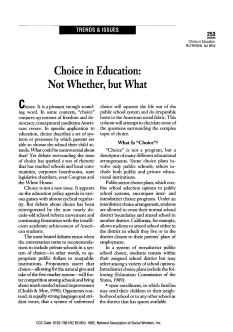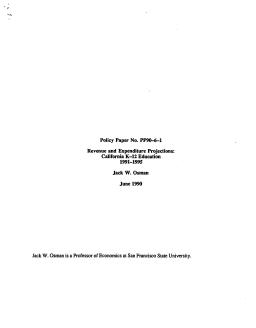A Weighted Pupil Formula for California
Published
Summary
Governor Jerry Brown has called for a major overhaul of California’s school finance policies. His proposal for a weighted pupil funding system would simplify the rules that govern the distribution of funds to schools and school districts, while targeting a larger share of available resources to the schools and students with the greatest needs. In this policy report Mary Perry offers an overview and analysis of the policy change that the Governor has proposed.
How 10 Districts Responded to Fiscal Flexibility, 2009–2010
Published
Summary
This report explores how 10 California school districts responded to the deregulation of $4.5 billion in education funding, which became entirely flexible in 2009. The study investigates how district leaders made budget decisions and what local factors influenced their responses. The research was conducted by a team of scholars from the RAND Corporation, UC Berkeley, UC Davis, and San Diego State University.
Revenues and Expenditure in the First Year of Categorical Flexibility
Published
Summary
This report discusses the effects of California's partial release of categorical funds to local school boards in 2009. The increased flexibility has provided an opportunity to observe how districts respond to the policy change, but the impact is difficult to isolate as most districts have been struggling to maintain core services during a severe budget crisis. The report includes preliminary results from an ongoing study of district responses to the increased categorical flexibility.
Structuring School District Discretion over Teacher Employment
Published
Summary
This brief analyzes the relationship between teacher employment, collective bargaining laws, and school district policies in California. The authors examine the extent to which California's legal structure constrains or facilitates district-level discretion over teacher employment policies and practices. They classify various aspects of the teacher-school district employment relationship into four categories, and conclude that California statutory law is somewhat more constraining of administrative decision-making in teacher employment matters than in four other large and diverse states.
California’s Quality Education Investment Act
Published
Summary
This working paper examines the use of Quality Education Investment Act (QEIA) funds, which allocated $2.6B over seven years to California's lowest-performing schools. The authors conducted a study of four Los Angeles high schools to investigate how QEIA dollars were spent in the first year, who made the decisions, and how funds were used to improve teaching and the instructional program. The study found that district officials and principals had discretion in allocating funds, consistent with recent efforts to deregulate categorical-aid programs and give local educators fiscal discretion.
Published
Summary
This article explores the reasons why education has become a central focus of modern societies and the largest public expenditure around the world. The state has built and expanded national education systems, made attending school mandatory, and linked adult success to academic performance. The article delves into the economic factors behind state financing and provision of schools.
Published
Summary
This article discusses how teacher recruitment and retention affect the quality of teaching in schools. The supply and demand model, including wages and non-pecuniary job attributes, influences the supply of potential and current teachers. The demand for teachers depends on factors such as student enrollment and institutional constraints such as hiring authorities' skill and efficiency. The article identifies common policy approaches to improve recruitment and retention and summarizes current research on their effectiveness.
Published
Summary
Economics of education has grown in importance over the past two decades, as education is viewed as a critical factor in a nation's economic success. Economics can help improve the productivity of educational institutions by focusing on incentives, choice, and competition. The article reviews important theoretical concepts in the economics of education, including human capital, markets, and education production, and how they have been used in empirical studies.
Minority Pay Gap Widens Despite More Schooling, Higher Scores
Published
Summary
African Americans and Latinos historically have lower educational attainment, achievement, and wages compared to whites. Narrowing education gaps between minorities and whites should narrow wage gaps. This report analyzes whether California's education gap improvement between minorities and whites led to a parallel reduction in wage gaps. The report finds that the educational attainment and achievement of California's minority youth improved significantly from the 1970s to 1988.
Published
Summary
This baseline analysis examines the projected need for teachers in California based on student enrollment projections, expected rates of new teachers and teacher retirements. However, it does not take into account recent policy changes such as the budget's call for reductions in class size or the proposed changes to teacher credentialing requirements. These changes will impact the need for teachers in California. The analysis shows regional teacher shortages, which are expected to persist despite the new policies.
Published
Summary
The education productivity problem is rising resources but only modestly rising student achievement. Current education reform aims to produce higher student achievement with stable resources. Low student performance may be due to declining social and economic conditions, lack of hard work by students, and lack of parental support. However, research focuses on what schools can do to improve productivity by controlling and improving student achievement. Both education programs and finance structures need to be restructured to accomplish productivity challenges.
Published
Summary
The 1995-96 California state budget increased K-12 education funding by $1 billion, but the additional funds were meant to be used for non-recurring expenses like deferred maintenance and facility upgrades. Lottery revenues were also intended for non-recurring expenses, but schools have come to rely on them for their core instructional program, despite decreasing revenues. This paper reviews the history of the California State Lottery as a funding source for schools and how non-recurring costs are interpreted in a system with shortfalls in core programs.
Financial Analysis
Published
Summary
The Californians will vote on Proposition 174 which will amend the state constitution to establish "scholarships" for kindergarten to 12th-grade schooling. These new schools will be publicly funded but may have privately selected governing boards and religious orientation. It is unclear whether they will be public or private schools. The paper attempts to reduce uncertainty regarding the financial consequences of the proposed voucher plan and address questions about public costs and possible cost savings.
Overview of PACE Analysis
Published
Summary
PACE has analyzed the financial, legal, and social ramifications of Proposition 174, the school choice initiative, so as to provide Californians and policymakers with accurate, unbiased information. This packet contains important questions and answers about the initiative, summaries of PACE's financial analysis and polling report, and background information on PACE and its directors.
The School Voucher Initiative
Published
Summary
The "Parental Choice in Education Initiative" or Proposition 174, will be voted on by Californians on November 2, 1993. PACE has conducted an analysis of the initiative's provisions to provide objective information to policymakers, parents, educators, and the public. PACE is not taking a stance on the initiative but has produced additional materials related to the initiative and the issue of school choice. These materials are listed in the attached report on school choice.
Increasing Teacher Salary Options
Published
Summary
Many new teachers leave the profession due to low salaries, which have only slightly increased despite requiring similar preparation to other professions. A possible solution is extended contracts made possible by year-round school schedules, which could raise salaries within restricted budgets. This study examines the effects of extended-year contracts on teacher satisfaction and burnout.
Published
Summary
California's education system has suffered from a lack of cohesive reform strategy since 1983 due to political and fiscal gridlock, and initiatives like Proposition 13 have limited state and local leaders' ability to fund schools adequately. To improve the system, California needs to overhaul its fiscal structure and formulate a new comprehensive reform agenda with the support of both political and educational leadership.
Published
Summary
School finance has become a prominent issue again due to court decisions and litigation in several states. This article explores school finance changes in the 70s and 80s and outlines key issues for the 90s, including the relationship between finance and education goals, site-based management, teacher pay, accountability, school choice, and nontraditional issues such as preschool and non-educational services for children.
Published
Summary
Funding for education in the US has grown significantly since World War II, but in California, spending for schools has lagged behind other states. Reasons for this include the taxpayer revolt of the late 1970s, competition for funds, changing demographics, and voter preferences. Many of the causes are rooted in the state tax system and school finance structure. Californians used to have a top school system but now have a lower-quality one due to these factors.
Not Whether, But What
Published
Summary
Debate over school choice has been reignited due to the school reform movement and frustration with low academic achievement. The conversation becomes heated when private schools are included in the system of choice, as proponents believe it will foster competition and improve schools, while opponents argue it will harm public schools and society. This article aims to shed light on the complex issue of school choice.
California and Senate Bill 813
Published
Summary
In 1983, the California legislature enacted a series of incentive programs intended, in part, to encourage local school districts to devote more resources toward instructional expenditures. Analysis of district response to those incentives shows they were more effective in directing spending toward direct instruction than were general or categorical grants. However, it appears that as the incentive funds were rolled into general aid revenues, district spending patterns began to revert to the same distribution of expenditures observed prior to enactment of the incentives.
California K–12 Education 1991–1995
Published
Summary
This report discusses the importance of forecasting revenues and expenditures for public sector planning and budgeting. It highlights three characteristics of California's recent experience. First, K-12 funding rose 91% from 1980 to 1989, but real revenue growth was tempered by inflation. Second, California relies more on state revenues for K-12 education than the rest of the US. Third, California's "effort" in raising K-12 revenues in 1986 was lower than the US average, and revenue efforts for both schools and other public functions are below the national average.
A Comparison of Education Reforms in the United States and Great Britain
Published
Summary
The new global economy is reshaping education worldwide, necessitating policies that expand access and enhance quality. Despite different educational systems, similar issues need to be addressed, resulting in an international convergence of education policies. The article discusses the emerging economy, educational challenges, policy alternatives, and compares recent reforms in the US and UK.
